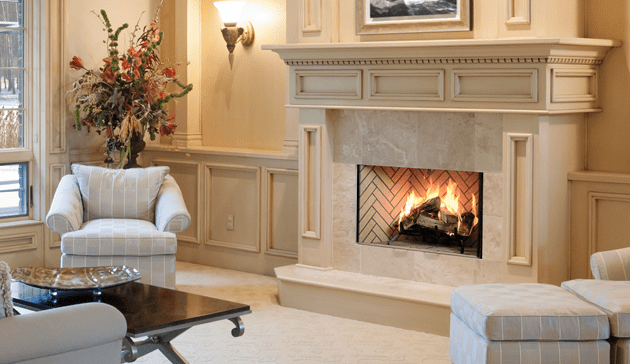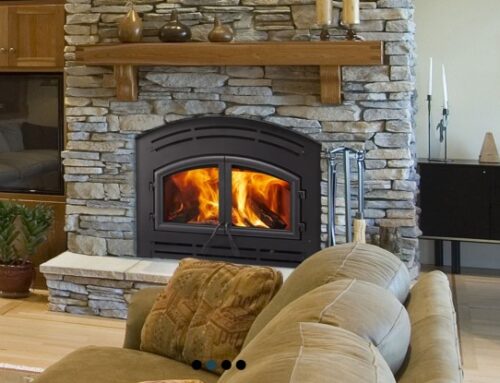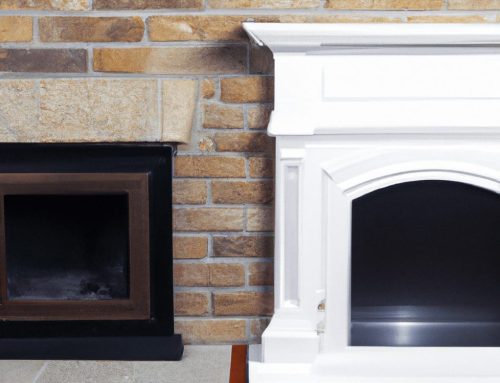When most people think of cold winter evenings, they think of fireplaces. Since the dawn of time, humans have gathered around the open fire for a sense of safety and community, and the fireplace is still the focus of family living in many homes, especially around the holidays, but in spite of all the glowing aesthetics, there are some practical considerations. When you’re dealing with an element as potentially dangerous as fire, knowledge really is power, so please read on to learn how to make your fireplace both safer and more enjoyable.
Wood burning fireplaces come in two general types, masonry fireplaces built entirely of bricks, blocks or stone and mortar, and factory built fireplaces consisting of a lightweight metal firebox and a metal chimney. (There are a few hybrids too, the most common being a heavy metal firebox and smoke chamber coupled to a regular brick chimney). To figure out which you have will take only a moment of detective work on your part.
A masonry fireplace has a firebox built of individual generally yellowish firebrick, a brick chimney above the roof, and if you look up past the damper you will see a roughly pyramid shaped affair also built of brick.
Factory-built fireplaces and chimneys have gained popularity in newer homes because both the material and installation costs are generally lower than for masonry fireplaces. Factory-built units are often referred to as “zero-clearance” or “prefab” units. When properly installed, these units are safe and some models are very efficient and EPA rated. It should be understood that they will not last as long as a masonry fireplace and depending on quality, use, and location should be expected to last twenty to forty years before requiring replacement.
When you’re buying a home, be sure to have a certified chimney professional check the fireplace to make sure it is functional and does not need repairs.
After you’ve moved in, have a certified chimney professional clean and inspect the fireplace annually to make sure it’s safe. Many homeowners mistakenly believe their fireplace does not require any maintenance. The fact is all fireplace types from wood to gas to electric should undergo annual maintenance. For example, gas fireplaces need the fan, pilots and burners checked each year. And wood fireplaces require an inspection and chimney cleaning to remove creosote, which can build up and cause chimney fires.
Whether your fireplace and chimney is masonry or factory-built has little to do with the countless hours of enjoyment you can gain from using it. The keys to safe and enjoyable fireplace use are proper construction followed by appropriate maintenance and operation.
Homeowners should also check the chimney or vent before the season’s first fire to see if birds or animals have built nests in it, or if leaves or other debris have accumulated. At a minimum, homeowners should also install a carbon-monoxide alarm in the same room as the fireplace and another one near the bedrooms.
Homeowners can handle much of the day-to-day maintenance; however, most tasks are better left to a professional. Here are some tips for getting the fireplace ready and keeping it in tip top shape this winter:
General Maintenance:
Wood Burning Fireplaces
Clean out the firebox at least every week when using the fireplace regularly, but leave an inch of ash in the bottom to act as insulation.
NOTE: Never use a household vacuum to clean out the firebox as coals can stay hot for several days after extinguishing a fire.
Before removing ash, open the damper so loose ash is drawn up the chimney rather than out into the room.
Remove all ash during the months the fireplace is not in use.
Burn only seasoned hard wood in the fireplace. This will help minimize creosote buildup in the chimney. Burning small, controlled, hot fires rather than smoldering fires will also help keep creosote under control.

Chimney Cap
Check Chimney Caps
A cap fitted with wire mesh sides covers the hole at the top of the chimney. It keeps rain, birds, animals, and debris from entering. Replace or repair a cap that is missing or damaged.
Inspect Masonry Chimneys
Examine the outer mortar between bricks or stone to make sure it is intact. Shine a flashlight down the chimney to look at the mortar inside. If the mortar is crumbling, it must be replaced. Look for cracked tile liners or missing bricks, too.
Inspect Metal Chimneys
Look for dented or rusted metal and missing screws at joints.
Watch for Formation of Creosote
Creosote is a flammable substance that is hard, dark, and crustlike. It is produced during incomplete combustion of wood. An accumulation of creosote can cause a dangerous chimney fire, so it must be removed.
You can minimize creosote by burning dry hardwoods, since their lower moisture content promotes more complete burning.
A hot fire produces less creosote than smoldering woods. Increase the air supply if necessary so that wood burns more completely.
Identifying Soot
Soot is a flammable deposit, dark in color but softer than creosote. Most chimney sweeps recommend cleaning when soot deposits reach 1/8-inch in depth.
Creosote Glaze
This shiny, tar-like product is flammable, and usually difficult to fully remove.
Smoke
If there’s smoke in the house, and you’ve eliminated chimney debris, make sure the damper is open. If lots of smoke is coming out the chimney, it means that wood isn’t burning complete.
Gas Fireplaces
Always consult your owners manual before attempting any kind of service.
Vacuum the firebox and heat exchanger regularly (only when the fireplace is cold, of course) to keep efficiency and air quality high.
Consult a professional to clean the pilot assembly, purge trapped air from the gas supply line, and then test-fire the fireplace.
Use only a soft brush to remove dust or spider webs from gas logs since they can be fragile. Make sure to position logs properly after cleaning to avoid sooting.
Use glass cleaner made especially for gas fireplaces to clean the glass front – never use oven cleaner or abrasives.
Electric Fireplaces
Clean the firebox and control compartment with a brush and vacuum.
Never use glass cleaner to clean the back of the glass, use only mild soap and water. Remove dust particles from glass by simply buffing lightly with a clean, dry cloth.
Replace the light bulbs about every two to three years or when the flame and/or ember bed is dark on one side.
Follow the manufacturer’s instructions or consult a professional on cleaning the heater system to extend the fan’s life.














Leave A Comment
You must be logged in to post a comment.